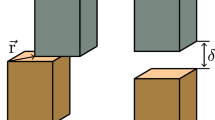Abstract
In this paper, a sensitivity and general uncertainty analysis is performed related to the modified embedded-atom method (MEAM) potential calibration of pure aluminum for data garnered from lower length scale (ab initio) simulations. Input uncertainties were quantified from 95% normal distribution confidence intervals of the various calibrated MEAM potential parameters from Part A of this study. A perturbation method was used to quantify the MEAM sensitivities to input parameters. The input uncertainties and sensitivities were then combined in a general uncertainty propagation analysis method. The results of the sensitivity analysis show that all the MEAM parameters interdependently influence all MEAM model outputs to varying degrees, allowing for the definition of an ordered calibration procedure to target specific MEAM outputs. In relation to the generalized stacking fault energy (GSFE) curve, the coefficient of the embedding function related to the background electron density, asub, was the most influential parameter related to the first peak. The first peak of the GSFE curve is related to unstable dislocations, in effect dislocation nucleation, and the first trough is related to stable dislocations. This connection of tying asub to the dislocation nucleation and motion was not obvious before this study indicating the power of the sensitivity and uncertainty method that was employed.





Similar content being viewed by others
References
M.I. Baskes, Phys Rev B 59, 2666 (1987).
M.I. Baskes, Phys Rev B 46, 2727 (1992).
B.J. Lee, Acta Mater. 85, 701 (2012).
B. Jelenik, S. Groh, M.F. Horstemeyer, J. Houze, S.G. Kim, G.J. Wagner, A. Moitra, and M.I. Baskes, Phys Rev B 85, 245102 (2012).
C. Cruz, P. Chantrenne, R.G.A. Veiga, M. Perez, and X. Leber, J. Appl. Phys. 113, 023710 (2013).
M.F. Horstemeyer, Integrated Computational Materials Engineering (ICME) for Metals: Reinvigorating Engineering Design with Science (Hoboken: Wiley Press, 2012).
M.F. Horstemeyer, J.M Hughes, N. Sukhija, W.B. Lawrimore II, S. Kim, R.L. Carino, and M.I. Baskes, JOM, this issue (2014). doi:10.1007/s11837-014-1244-0.
H.W. Coleman and W.G. Steele, Experimentation and Uncertainty Analysis for Engineers (New York: Wiley, 1999).
M. Pusa, Sci Tech Nucl Install 2012, 157029 (2012).
Acknowledgements
The authors would like to acknowledge the Center for Advanced Vehicular Systems (CAVS) at Mississippi State University for support of this work.
Author information
Authors and Affiliations
Corresponding author
Appendix A: Modified Embedded-Atom Method (MEAM) Equations
Appendix A: Modified Embedded-Atom Method (MEAM) Equations
Universal Binding Energy Relationship (UBER)
Background Electron Density
Embedding Function
Pair Potential
MEAM Parameter Descriptions:
-
(1)
alat—lattice constant of reference structure
-
(2)
esub—energy per atom (eV) in the reference structure at equilibrium
-
(3)
attract—additional cubic attraction term in Rose energy I-J pair potential
-
(4)
repuls—additional cubic repulsive term in Rose energy I-J pair potential
-
(5)
Cmin—screening parameter when I-J pair is screened by K
-
(6)
asub—“A” parameter in MEAM embedding function
-
(7)
b1, b3—β (l) terms in electron background density functions
Rights and permissions
About this article
Cite this article
Hughes, J.M., Horstemeyer, M.F., Carino, R. et al. Hierarchical Bridging Between Ab Initio and Atomistic Level Computations: Sensitivity and Uncertainty Analysis for the Modified Embedded-Atom Method (MEAM) Potential (Part B). JOM 67, 148–153 (2015). https://doi.org/10.1007/s11837-014-1205-7
Received:
Accepted:
Published:
Issue Date:
DOI: https://doi.org/10.1007/s11837-014-1205-7




